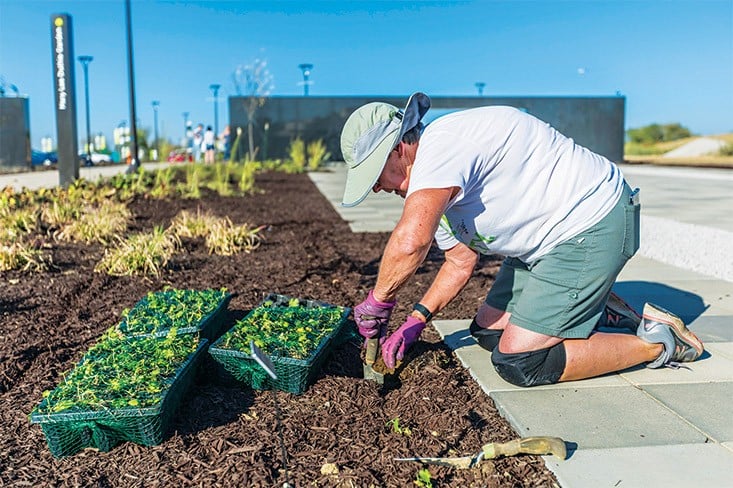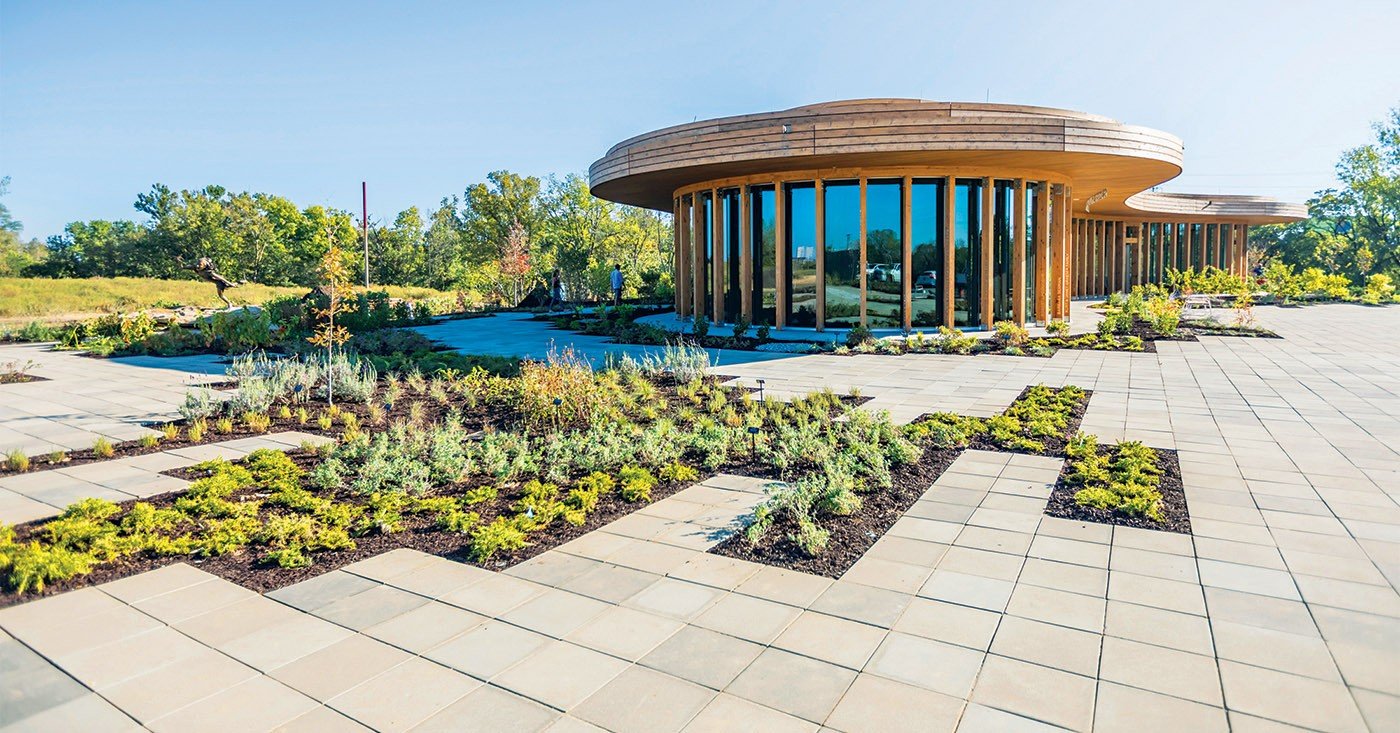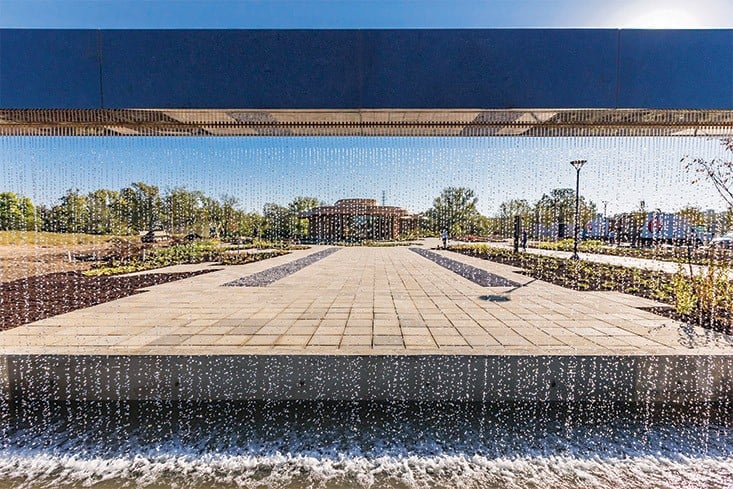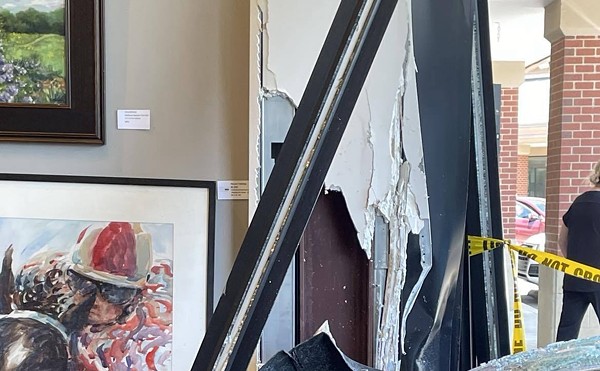In the beginning — long before all the fountains and flowers — there was the elegantly named Ohio Street Dump. It was first created near what is now River Road and Frankfort Avenue with bulldozed debris from the Great Flood of 1937 that buried nearby houses and stores in an area called “The Point” under 30 feet of dark and murky waters.
In the following, pre-Environmental Protection Agency years, tons of garbage, old washing machines, busted concrete, rusted pipes, glass, plastics and animal carcasses were added to the dump — or just tossed into nearby Beargrass Creek.
Wild hogs, marauding rats and hungry insects had the run of the place. In the 1940s, humans would dig into the growing hillside seeking scrap metals, paper and cloth for the war effort. In 1952, nearby residents were given a grand jury investigation into the fetid odors that hung over the creek and their neighborhood. There were even promises of a new, rehabilitated park for them — hold that thought.
Fires from hot coals dumped into the site — or started by scavengers burning the labels off cans — would roar for days, polluting the skies with thick, black smoke, tossing up angry flames, even incinerating nearby occupied slum houses.
It was hell on a garbage pit.
In 1973, the dump, which had risen to almost 30 feet of trash above River Road, was closed, slowly capped with varying levels of available dirt. Then, came invasive shrubs, trees and homeless camps — each carefully removed over time. Over the next 40 years, all necessary environmental due diligence was completed and approved. No serious pollution remained — not counting Beargrass Creek.
Moving quickly forward — last week, actually — thousands of people helped celebrate the further remaking of the Ohio Street Dump with the opening of the 23-acre Waterfront Botanical Gardens and 6,000-square-foot Graeser Family Education Center, just a few miles from downtown Louisville and bridges to Southern Indiana.
Beauty Finally Begins To Take Control Of The Beast
The Waterfront Botanical Gardens will be a three-phase project costing an estimated $60 to $70 million, with the phase-one goal of about $16 million already close at hand, the biggest boost to that a roughly $5 million bequest from the estate of Ellen Tetzel Leslie. The gift came as a complete surprise. When she died at 87, the gardens found out that she had left them the money in her will, even though she had had no contact with anyone there before her death. “She couldn’t wait to go down there and see it. She loved the whole idea,” said Marilyn Taylor, a longtime friend and neighbor of Leslie who became the executor of her will.

The gardens — a long held dream going back more than 30 years and through several false starts — now has a very active and diverse board, 500 members, a mailing list of more than 7,000 people, a donor list of 1,500 and a staff of 10.
Its prime goal is education — child and adult — with the added economic benefit of tourism and improving the quality of life in Louisville, one of the biggest cities in the country without a dedicated botanical garden. The gardens will also serve as a host and central communications center for all area garden organizations.
The gardens’ overall design was created by Perkins+Will of Atlanta. But Jamie Burghardt, the gardens’ director of horticulture and education, is shepherding the planting and planning. He estimated the first phase will include about 10,000 to 12,000 flowers, shrubs and trees. The terrace area around the education center, which includes a fountain, walkways, water wall, benches, shrubs and forthcoming pollinator gardens, was created with about 12,000 pavers — one at a time.
It was largely funded with gifts from George and Mary Lee Duthie — she an avid gardener — whose contributions have totaled $1.7 million. A Japanese garden will also be fitted into the first phase — a further gift from the Graeser family.
Poor Soil, Best City View
You can see first evidence of the garden’s early plantings driving up the curved, sloped entrance off Frankfort Avenue. One bank is a wall of red-tipped ornamental grasses, white-flowering itea shrubs, buckeye trees, a broad rainbow of rudbeckia, coreopsis and cone flowers and a bark-shedding paperbark maple.
There’s a welcoming feel as you drive up the steep road to the crest; the new flower and shrub gardens tentative, hopeful and coated in mulch. Beyond that there is still so much open, bare and weedy ground to be planted, part of that now a temporary parking lot.
The top of the hill offers the best view of downtown Louisville this side of the Southern Indiana shoreline; the city skyline perfectly placed on the horizon. Future plans here include an elevated, grassy walkway above a visitor center and restaurant that will make the higher view even more spectacular; Thunder, et al. The final gardens' phase will include a large, glass conservatory for year-round visitors.
Burghardt, a tall, slim, knowledgeable man, has served in managerial positions in botanical gardens in Fort Collins, Colorado and Savannah, Georgia and more recently has spent long days with a shovel and plants in his hands helping a busy crew of volunteers with the last-minute work.
Burghardt said a belief that the Louisville site is naturally good for plants because it was once a decaying landfill doesn’t fit its working reality. Soil added years ago to cap the dump is of dubious horticultural value; crusty-hard with nutrient deficiencies. It needed to be broken up and amended with alfalfa pellets to boost nitrogen and be more useful to the various plants. Along with adding better soil and mulch to make the site work, Burghardt is also dealing with an exposed, windy, full-sun area that dries out very quickly.
“We’re combating shallow soil because we are on top of a city dump or debris field,” he said. “We’re adding soil, but around it we do not know what we might encounter.
“Luckily, all the planting holes that we’ve been digging haven’t been deep enough that we would get down where there’s historic debris, but we may find that once we begin planting the large rootballs, with the trees.”
Serious drainage issues have included working around the gravel and concrete near the education center and sidewalk and the dense substrate used for pavers. The continual soil compression caused by all the multi-ton construction equipment has also been a problem.
“We’re trying to get as much gravel removed as we can so there will be as much soil volume as possible for the perennial grass and shrub roots to be able to grow out over several years,” Burghardt explained.
The timing on all that has also been an issue.
Waiting for the educational center, entrance roads and electrical and plumbing systems to be completed, along with miles of irrigation system to be installed over acres of gardens, delayed much of the planting into the brutal, record-hot days of late September and early October.
One Burghardt-designed flower bed of annuals near the entrance to the education center already helps with instant impact. It features bright red and orange-yellow ornamental peppers, spikey-pink cockscomb, orange lantana, blue asters, red-purple mustard and rust-tinged sedge, all glowing in the shimmering light of a setting sun.
Burghardt’s short range plan for the gardens — and there will still be about 15 to 18 acres to plant — is “let’s hold our horses at first because we first need to establish a healthy soil environment.”
“But then,” he said, “as the trees grow, it allows us to bring in more shade-loving plants. We’ll just have to wait until we have the right growing environments.”
Once improved soil and shade are established, Burghardt plans to bring in newer cultivars of old favorites to add diversity. One example is the flowering abelia with such varied cultivars as confetti, dwarf purple, rose creek and sunrise, their colors matching their names.
In the botanical winterberry world — shrubs that offer spring flowers and hundreds of bright berries in late fall and winter — Burghardt said the gardens would go with the tried and true “winter red” but he was already trying new cultivars such as “berry heavy” (gold berries) and “berry poppins” (prolific red berries on a dwarf plant).
“There’s been a lot of plant breeding and introduction in the past 20 years and older botanical gardens may not have the space for them, “he said, “whereas we don’t have that problem.”
Burghardt sees the Waterfront Botanical Gardens as a living laboratory. He’s curious if being 30 feet in the air in an urban heat island will enable him to grow plants normally grown in more southern climates. He wants to experiment, try new things, but not until he is sure what problems the old landfill has left him.
“I think because of our unique history,” he said, “and the fact we are on top of an old city dump, our legacy for a generation will probably be what we are doing now, that we are growing plants. We’re a botanical garden on top of an old brownfield, but as we get more familiar with climatic conditions up here... well… we really need to find out.
“And Louisville being the northernmost southern city or the southernmost northern, here’s a prime opportunity where you can show northern species or southern species, whether they’re native or exotic, co-existing in a garden and being well done.
“And that would not only excite local horticulturists and gardeners but would amaze tourists.”
Availability permitting, flowers to be planted around the modern, curved-glass education center and nearby raised bed pollinator and native gardens include cardinal flower, slender mountain mint, monarda, salvia, native columbines, purple milkweed, aromatic asters, amsonia, agastache, butterfly weed, caryopteris, geranium and penstemon.
The list of shrubs and ornamental trees to be planted across the upper level of the gardens include viburnum, hydrangea, fothergilla,witchhazel, bottlebrush buckeye, red buckeye, fringe tree, yellowwood, black gum, beech, dogwood, redbud,and — hey, you better have these up there — Kentucky coffee trees.
Other Landfills-To-Treasures
While the Waterfront Botanical Gardens is experimental around here, Burghardt said there are at least three other botanical gardens in the country that have been successfully built on dumps, landfills or quarries.
One is the Brooklyn Botanic Garden, a now 52-acre garden which was built over a rock or sand quarry filled in with soil and originally designed by — who else — the Olmsted brothers.
“It’s now covered with large, mature trees,” said Burghardt. “It was probably the first example in the United States of there being a former brownfield that has been used by a botanical garden as part of their general collection.”
The South Coast Botanic Garden, an 87-acre site in Palos Verdes, California and now with 150,000 healthy plants, was an open pit diatomite quarry from 1929 until 1956. It became a landfill until 1965 as 3.5 million tons of refuse were dumped into the hole, then covered with mostly diatomaceous earth, which broke down in various speeds and places, causing cave-ins and serious irrigation problems.
The good news — sort of:
“There was a lot of haste in converting that landfill,” said Burghardt, “And that kind of informed the industry in general about the challenges in being on top of a landfill.”
Closer to home, and somewhat of a model for Louisville, is the Lauritzen Gardens at the Omaha Botanical Center. It’s a 100-acre site which is also close to the city’s center and offers a needed bloom-where-you’re-planted mentality. It’s motto: “Escape to an Urban Oasis.”
It is a different model, Burghardt said, in that Lauritzen first crushed all garbage bags and debris into cubes, placed them in a protective lining in a basin, then covered in dirt.
“They have chosen not to put trees and buildings on top of the actual landfill refuse,” he said. “The areas where there is debris under it, they are keeping in lawn.
“So it’s a different approach because every landfill is different, based on the soils and the debris. Each one has some commonalities but there’s a lot of unique problems, or challenges.”
In dealing with that issue, initial plans for Louisville’s educational center had to be revised to remove a planned basement, and footers were sunk down to bedrock below to keep it stable.
Over 20 years, the Lauritzen Gardens, a public-private partnership, has added many specific flower gardens, a glass-encased visitor center, a model railroad garden, a children’s garden and a Japanese garden, a string of festival and seasonal events and a steady advance of volunteers and donors.
Some of that has already happened in Louisville.
It Takes A City
Thanks to the Graeser family gift, Waterfront Botanical Gardens board members have been in contact with internationally recognized Japanese gardens designer Shiro Nakane to create a garden on the western edge of the botanic gardens, with input from the Louisville Bonsai Society.
In that same vein, the Louisville Area Daylily Society will be part of a mixed-bed Helen Harrigan Garden named for the woman who in 2001 left a $1.5 million trust to help establish a botanical garden in Louisville. TreesLouisville also donated 100 dogwood, sugar maple, red maple and oak trees to help hold the soil on the back side of the gardens above Beargrass Creek.
Future plans include an arching, pedestrian overlook of the creek. The slope below will be covered in flowers, shrubs and trees with a path down to Beargrass Creek and its walking path. With botanical gardens, it’s always about the future.
One other similarity to the Louisville site and Lauritzen Gardens is both have been created near interstate highways. In Louisville’s case, Interstate 71 flows past just below the gardens’ eastern edge. The state of Kentucky planted trees along I-71 to help ameliorate the noise. Kevin Bowling of Bowling’s Nursery is dealing with more comprehensive planting along the slope to both hinder noise and add beauty on the way in.
The lower area of the slope has been planted in a tight row of arborvitae, juniper, holly and with magnolias added to bring some six-inch white blooms to the mix. All will grow at least 15 to 20 feet tall in time, blocking out most highway sounds. Further up the slope, greeting all those who enter, is a long, jubilant, fragrant row of blue spruce, hydrangeas, viburnums, sweet shrub, ninebark and Japanese pagoda trees.
Counting all the plugs of grasses and perennials at the entry slope and the highway parade of shrubs and trees, Bowling estimated his crew would place from 4,000 to 5,000 plants. The steep slope at the bottom presented the most issues.
“We have to be careful not to plant too deep,” he said, “and to build a little ridge of dirt behind the back side.”
Even now, those I-71 highway sounds tend to dissipate nearer the center of the garden; the mind focused on the plants, fountains, a water wall and the long-range view of Louisville.
The noise disappears inside the education center, where all views to the surrounding plants outside are good and the Waterfront Botanical Gardens board holds its monthly meetings. It’s most recent meeting, with various committee reports being given, was filled with the same optimism that led to the unanimous vote to build the gardens in the first place.
Growing plants in uncertain soil in record temperatures will certainly lead to some losses, a reality all gardeners face. When your goal is converting a fire-scarred dump into a lush landscape, the feeling among the volunteer Waterfront Botanical Gardens board has always been the risk is worth the rewards. It’s an opportunity to give back to a community that’s given so much to them.
It’s working motto: This is where we grow. •
Bob Hill is volunteer member of the board of Waterfront Botanical Gardens and helped with the garden design.










